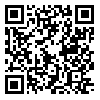Volume 14, Issue 1 (2014)
QJER 2014, 14(1): 59-77 |
Back to browse issues page
Download citation:
BibTeX | RIS | EndNote | Medlars | ProCite | Reference Manager | RefWorks
Send citation to:



BibTeX | RIS | EndNote | Medlars | ProCite | Reference Manager | RefWorks
Send citation to:
Shakibaei A, Shadmani G. Estimating the Size of Shadow Economy in Iran Using Multi-level Fuzzy Modeling. QJER 2014; 14 (1) :59-77
URL: http://ecor.modares.ac.ir/article-18-1773-en.html
URL: http://ecor.modares.ac.ir/article-18-1773-en.html
1- Associate Professor of Economics, Faculty of Economics and Management, Shahid Bahonar University of Kerman
2- Ph.D. Student of Economics, University of Mazandaran
2- Ph.D. Student of Economics, University of Mazandaran
Abstract: (10936 Views)
Estimating the size of shadow economy is of special importance in setting macroeconomic variables and fiscal policies. In recent years, the fuzzy inference sets have been used for measuring shadow economy. In this paper, we present eight new fuzzy indicators for modeling and estimating the size of shadow economy. Thus, according to Lucas definition, we divide the shadow economy into four sectors and define two indicators for each sector. After three fuzzy inference phases, we measure the size of shadow economy. Our results indicate that the effect of production household on Iran’s shadow economy size is decreasing; and irregular, informal and illegal sectors impact size of shadow economy. In addition, the size of Iran’s shadow economy is estimated around 13 percent of GDP, on average, over 1970- 2007.
Received: 2012/01/29 | Accepted: 2012/10/3 | Published: 2014/03/10
| Rights and permissions | |
 |
This work is licensed under a Creative Commons Attribution-NonCommercial 4.0 International License. |







